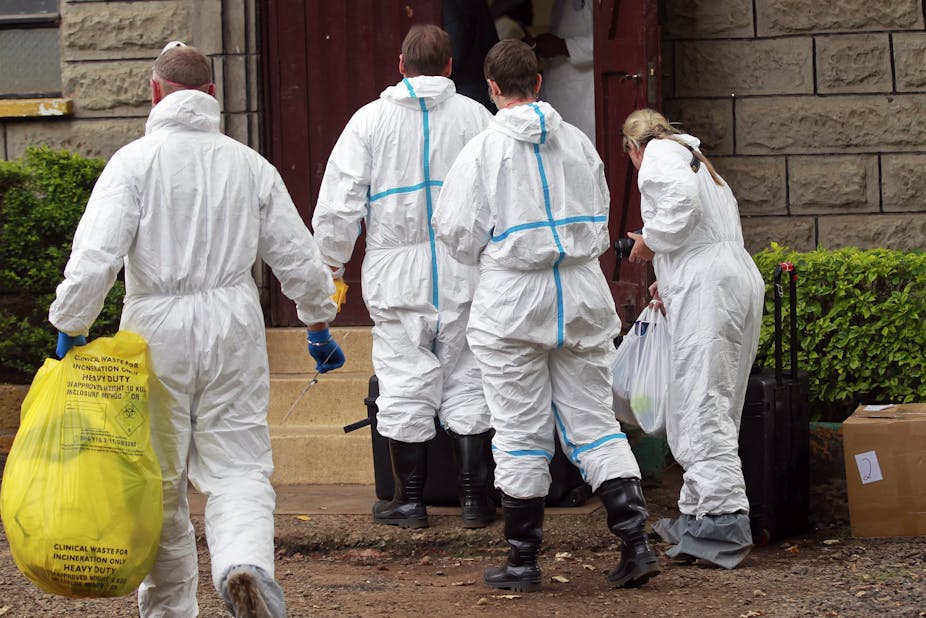The entire world witnessed last month’s horrifying terrorist attack on the Westgate mall in Nairobi, Kenya. Now forensic experts from Interpol, US, UK, Germany, and Canada have joined Kenyan law enforcement to investigate the siege. What do these scientists hope to find in a mass crime site as challenging as the Westgate?
“Every contact leaves a trace” is the fundamental principle which underpins any forensic inquiry. Imagining the physical contacts that took place at Nairobi’s Westgate for four days - and the numerous traces left over - can help us visualise the complex tasks awaiting the arriving forensic experts.
Who are all these forensic experts?
In Nairobi’s attack, numerous forensic disciplines and fields of expertise will be involved in untangling the crime.
Forensic psychology steps in during the crisis to support plans to release hostages and arrest gunmen, and following the crisis through counselling survivors. Data collected in this process will help identify features of the criminal behaviour of the terrorists.
Crime scene investigation will determine the area of the crime site so as to control access to it, and to photograph, identify and develop any traces left by the criminals.
Forensic pathologists will be mainly concerned with the cause and manner of death. They will also examine injuries on survivors.
Forensic biologists (covering DNA profiling and genetics) will help identify dead bodies (mostly buried under the rubble). They will also identify biological remains recovered from the crime site. Advancements in the field of forensic genetics will help identify the race and ethnicity of the person to whom a body or a tissue relates.
Forensic chemists employ chemical testing and analysis and provide support to the various forensic fields. For example, they help crime scene investigators use the most efficient reagents to develop potential latent prints.
The team will likely also include fingerprint experts, explosive experts, and forensic ballistics and firearms experts to investigate bullets, cartridge cases, and machine guns. It would not be unusual to include forensic engineers, as three floors of the mall have collapsed.

Digital forensics will investigate the digital transactions which took place before, during, and following the attack. This includes computer and internet forensics, where investigation of desktops and laptops, analysis of network data, and detection and analysis of suspicious emails are expected.
Mobile device forensics, an emerging branch of digital forensics, will investigate digital evidence and data recovered from mobile phones, PDA devices, GPS devices and tablet computers. Telecommunication data analysis and footage from the mall’s security cameras are expected to reveal suspicious transactions.
Challenges and complexities
Forensic investigators - regardless of their field of expertise - will have to closely collaborate. One investigation will inform another. There are many instances where the same evidence will be observed from two disciplinary lenses; for example, a recovered bullet with blood traces will involve the skills of both forensic biology and forensic ballistics.
Forensic experts are arriving in Nairobi from all over the world. These experts come from different jurisdictions, where forensic practices and protocols are dissimilar to one another. All will have to default to the Kenyan jurisdiction. A fair amount of recruitment and training will be needed to identify such differences and potential responsibility clashes.
One of the main challenges will be the numerous traces left and the level of contamination affecting some of these traces. In an unusual crime scene such as the Westgate shopping complex, traces left by customers, staff, and gunmen (fingerprints, footprints, biological traces, tool marks, etc) just before, during, and immediately following the attack will be extensive. And on many surfaces, they will overlap.

Law enforcement and health staff who entered the site following the attack will have definitely contaminated the crime scene, leaving traces themselves as they attempted to rescue people and remove dead bodies.
With technological advancements and continuous research, forensic experts are achieving success in containing contamination of crime scenes. But with a huge crime site such as Nairobi’s the task will definitely be more demanding.
Forensic science investigation cannot escape context. Kenya’s ethnic diversity - and the different races, ethnicities, and nationalities of the Westgate customers, victims (dead and survivors) and offenders - will add another layer of complexity to the investigation, not the least to do with DNA profiling and forensic genetics.
Forensic experts are humans first and foremost. They will be affected by media pressure when it comes to the expectation of what they can reveal and how quickly they are able to do so.
Much is expected
The crime is a mass one and the crime scene, huge. Given all the complexities and challenges, forensic investigation will definitely not be as quick as we see in the TV show CSI. Though some preliminary results may start emerging in several weeks, it will require several months to conclude the investigation.
The forensic science team of experts will be expected to accomplish a number of tasks.
With several bodies under rubble, prompt identification will be required. The forensic team will have a major role in crime plot reconstruction.
The forensic investigation will either confirm or deny reports that a number of fighters fled the mall. It will also investigate whether all the terrorists were Somali and Kenyan, as there are reports about involvement of British and American militants.
Through the identification, recovery, and analysis of evidence the team will be required to contribute to a “beyond reasonable doubt” prosecution of offenders.
Finally, forensic experts at Nairobi, through seemingly unending work hours with physical, biological, and digital evidence at a complex crime site, play a major role in achieving justice, re-establishing lost security, and in the grieving process of the community.


